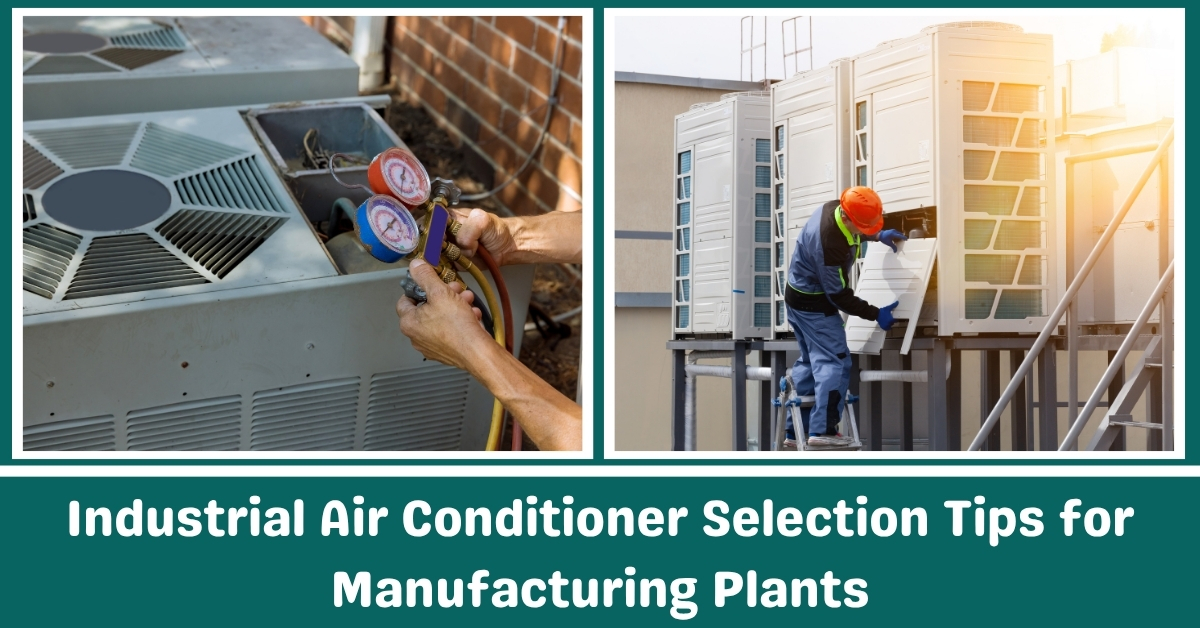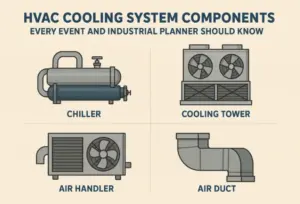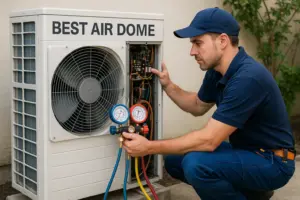Industrial air conditioner systems play a critical role in the smooth and efficient operation of manufacturing plants.
Unlike residential or light commercial AC units, industrial systems are built to handle high heat loads, large square footage, and constant operation under challenging conditions.
In a manufacturing environment, factors such as machine-generated heat, air quality, humidity levels, and worker comfort all demand precise and reliable temperature control.
Poor air conditioning can lead to equipment failure, reduced worker productivity, product defects, and even non-compliance with regulatory standards.
Selecting the right industrial air conditioning system isn’t just about choosing a powerful unit. It involves detailed calculations, understanding system types, evaluating energy efficiency, and ensuring long-term maintenance support.
With the growing focus on operational efficiency and energy conservation, making an informed, data-driven choice is more important than ever.
Overlooking key selection criteria could result in high running costs, frequent breakdowns, or expensive retrofits later.
Industrial Air Conditioner Selection Tips for Manufacturing Plants
In this guide, we will explain everything you need to consider when selecting an industrial air conditioner for your manufacturing plant—from load calculations and system types to ventilation, efficiency ratings, and future scalability.

Why Industrial AC Selection Matters
Choosing the right industrial air conditioner for a manufacturing plant is not simply a matter of comfort. It’s a matter of performance, safety, energy efficiency, and compliance.
Manufacturing operations produce substantial heat from machinery, processes, and human activity. Without a reliable and correctly sized air conditioning system, the environment can quickly become unstable, impacting worker health, product quality, and equipment longevity.
According to OSHA, working temperatures above the recommended levels can cause fatigue, heat stress, and reduced focus, directly lowering worker output.
Overheated machines are more prone to failure, while sensitive products especially in electronics, food, or pharmaceuticals may become defective under fluctuating temperature or humidity conditions.
Poor ventilation and air circulation can also lead to a buildup of contaminants in the air, violating safety regulations.
In short, proper AC selection supports operational continuity, product consistency, energy savings, and long-term cost control. Making an informed choice is not optional it’s essential for maintaining efficient plant performance.
Know Your Cooling Load (BTU/hr or Tons)
Cooling load refers to the amount of heat energy that must be removed from a space to maintain the desired indoor temperature. It’s measured in BTUs per hour or tons of cooling, with one ton equal to 12,000 BTU/hr.
Estimating the cooling load accurately is one of the most important steps when selecting an air conditioning system for an industrial facility.
A rough estimate can be made using formulas that consider square footage (typically 20-30 BTU per square foot), number of workers (400 BTU per person), lighting loads, and heat generated by machinery.
However, professional calculations such as Manual N or J methods are strongly recommended for precision. Factors such as ceiling height, insulation, window exposure, process-generated heat, and operational schedules must be considered.
Undersized systems will struggle to maintain temperature, causing breakdowns and overuse. Oversized systems, on the other hand, will cycle on and off frequently, leading to inefficiency and wear.
An accurate load calculation ensures the system operates efficiently and consistently without unnecessary energy waste or stress on components.
Prioritize the Right Type of System
There are several types of air conditioning systems available for industrial use, each suited to different facility layouts and climate requirements.
The most common types are central air conditioning, ductless mini-split systems, and evaporative coolers.
Central AC systems are ideal for large, open, or single-zone manufacturing areas where consistent cooling is needed.
These systems distribute cool air through ductwork and are efficient for large-scale operations but require a higher initial installation cost.
Ductless mini-split systems are better suited for facilities with multiple zones or when retrofitting older buildings. They provide individual control for each zone and can be installed without extensive ductwork.
Evaporative coolers, commonly used in dry climates, offer a cost-effective solution by using water evaporation to lower temperatures.
However, they are ineffective in humid environments. When choosing the system type, consider the size of the facility, the internal layout, regional climate, installation costs, and future expandability.
The right type of system ensures proper cooling distribution, minimizes energy consumption, and offers the flexibility to adapt to operational changes.
Don’t Ignore Energy Efficiency (EER & SEER Ratings)
Energy efficiency is a key factor in long-term operational costs. Industrial air conditioners consume large amounts of electricity, and efficiency ratings help determine how much cooling output is achieved per unit of energy consumed.
The Energy Efficiency Ratio (EER) measures the system’s cooling output (BTUs) divided by its energy input (watts), under specific conditions.
The Seasonal Energy Efficiency Ratio (SEER) extends this by evaluating performance over a range of outdoor temperatures, reflecting real-world seasonal changes.
Higher EER and SEER ratings mean better efficiency. A system with a SEER of 16 or more and an EER of 11.5 or higher is considered efficient by today’s standards.
Investing in a high-efficiency model may have a higher upfront cost but offers significant savings in electricity bills over time. Additionally, these systems often qualify for energy rebates or tax credits.
Lower energy use also means reduced environmental impact, supporting sustainability goals. Always review and compare these ratings when selecting between different models and manufacturers.
Account for Ventilation and Indoor Air Quality
Cooling alone does not guarantee a healthy or productive industrial environment. Proper ventilation is equally important to manage indoor air quality (IAQ).
Manufacturing processes often release dust, chemicals, smoke, or heat that need to be extracted and replaced with fresh air.
Without adequate ventilation, air can become stale or contaminated, leading to health risks and potential regulatory violations.
Air handling units (AHUs), exhaust fans, and make-up air units are often integrated into industrial HVAC systems to maintain air exchange.
Facilities handling hazardous materials may require advanced filtration systems such as HEPA filters, activated carbon filters, or even scrubbers.
Local building codes and OSHA standards typically outline minimum ventilation rates that must be met. When designing or selecting an AC system, ensure it works in coordination with ventilation components.
A good IAQ plan supports employee safety, reduces absenteeism, and protects the integrity of both products and equipment.
Plan for Humidity Control
Humidity levels have a direct effect on both human comfort and process quality in a manufacturing plant. High humidity can cause condensation, corrosion, mold growth, and defects in sensitive products like electronics or pharmaceuticals.
Low humidity, on the other hand, can cause static buildup and dryness in certain production processes. Ideally, humidity should be kept between 40% and 60% depending on the type of work being performed.
Industrial air conditioning systems should include dehumidification capabilities, either built-in or as standalone units.
In environments with high ambient moisture or where humidity is generated by internal processes, desiccant dehumidifiers or mechanical dehumidifiers may be required.
For cold environments, humidification might also be necessary. Maintaining consistent humidity prevents product loss, ensures worker comfort, and reduces the risk of equipment damage.
Humidity control should be part of the overall HVAC strategy from the beginning not added later as an afterthought.
Consider System Durability and Maintenance
Industrial environments are demanding, and the air conditioning system must be built to withstand long operating hours, airborne contaminants, and variable load conditions.
Durability depends on the quality of materials, design simplicity, and manufacturer reliability. For example, coils made from copper and coated with corrosion-resistant materials last longer, especially in coastal or high-humidity areas.
Choose systems designed for continuous duty, with rugged components and minimal moving parts prone to failure. Maintenance is also a key consideration.
Systems should offer easy access for filter changes, cleaning, and part replacement. Digital diagnostics and monitoring tools can alert technicians to issues before they cause breakdowns.
Select brands with strong local service networks and easily available spare parts. Preventive maintenance contracts should be considered for large or mission-critical systems.
A reliable, serviceable system reduces downtime, lowers repair costs, and maximizes return on investment.
Evaluate Noise Levels
Noise is an often overlooked but important factor in industrial HVAC design. Excessive noise from large AC units can interfere with communication, concentration, and safety.
Many industrial air conditioning systems operate at 70–90 decibels (dB), which may be acceptable in isolated areas but problematic in workspaces with employees nearby.
OSHA regulations permit exposure to 90 dB for an 8-hour workday, but prolonged exposure can lead to hearing damage.
Choosing low-noise systems, installing vibration isolators, acoustic enclosures, or locating equipment away from occupied zones are effective strategies.
Variable-speed fans and quieter compressor technologies are also available. In facilities with office areas or testing labs, low-noise performance becomes even more critical.
Including noise specifications in your system selection criteria ensures the working environment remains comfortable and compliant.
Factor in Automation and Smart Controls
Modern industrial AC systems come equipped with automation features that improve control and energy efficiency.
Smart thermostats, programmable timers, occupancy sensors, and IoT connectivity allow for real-time monitoring and adaptive cooling.
These systems can detect temperature changes, adjust fan speeds, and provide remote alerts for maintenance or performance issues.
Automation enables zone-specific cooling, which is especially beneficial in facilities with varied heat loads across different areas. For example, storage areas might require less cooling than assembly lines.
Integrated Building Management Systems (BMS) can also manage lighting, ventilation, and air conditioning together for optimal energy usage.
Smart systems reduce human error, optimize energy consumption, and extend equipment life. Look for systems that offer software support, data logging, and integration with your existing infrastructure.
Over time, these features provide measurable cost savings and enhance operational reliability.
Align with Utility and Government Incentives
Government and utility providers often offer financial incentives for investing in energy-efficient HVAC systems. These include rebates, tax credits, and low-interest financing programs.
In the United States, for example, Section 179 allows businesses to deduct the full cost of qualifying equipment purchases, including HVAC, from their taxable income in the year it’s placed in service.
Many energy providers offer cash-back programs for upgrading to Energy Star-rated equipment or systems that exceed certain SEER/EER thresholds.
To qualify, the equipment must often be installed by certified contractors and meet documentation requirements. These incentives can offset the higher upfront cost of premium or high-efficiency models, making them more accessible.
Before making a purchase, consult with local energy authorities or use online tools provided by the Department of Energy or equivalent agencies in your country.
Taking advantage of these programs can lead to significant cost savings during installation and over the system’s life cycle.
Size for Future Expansion
Manufacturing operations are dynamic. Whether you’re planning to scale up production, add new machinery, or build additional space, your HVAC system must be able to handle these changes.
This means thinking ahead during the selection process. Oversizing slightly (within reason) or choosing modular systems that can be expanded later is a smart move.
Modular systems allow you to add capacity without replacing the entire setup. Also, ensure that the electrical and ductwork infrastructure can support future upgrades.
Avoid the mistake of installing a fixed-capacity system that becomes inadequate within a few years. By accounting for growth, you reduce the risk of costly modifications or system replacements later.
A forward-looking HVAC design supports operational flexibility and helps maintain consistent environmental conditions as your business evolves.
Work With a Qualified Industrial HVAC Provider
Selecting and installing an industrial air conditioner should not be a solo decision.
Partnering with a qualified HVAC contractor ensures you receive accurate load assessments, proper equipment selection, correct installation, and ongoing support.
Look for providers with experience in industrial settings, relevant certifications, and strong references.
A good provider will perform a site survey, evaluate specific requirements such as zoning, ventilation, and humidity control, and propose a system tailored to your operation.
They should also offer post-installation training, warranty service, and maintenance packages.
Working with professionals minimizes the risk of sizing errors, poor airflow design, and compliance issues.
It also speeds up the project timeline and ensures peace of mind knowing your system is designed and supported by experts.
Conclusion
Selecting the right industrial air conditioner for a manufacturing plant is not a one-size-fits-all task it requires careful planning, data-backed calculations, and long-term thinking.
From determining your precise cooling load to choosing the right system type, every step directly affects performance, cost, energy consumption, and compliance.
Overlooking key factors such as ventilation, humidity control, or future expansion can lead to inefficient operations, product defects, or costly retrofits.
Prioritizing systems with strong energy efficiency ratings (EER/SEER), automation features, and low maintenance demands ensures you’re investing in a solution that will serve your facility reliably for years.
Working with experienced HVAC professionals can further reduce risks and optimize your setup from the start.
Remember, an industrial air conditioning system does more than keep temperatures low it protects your equipment, enhances worker productivity, and supports consistent output.
By making informed decisions and planning for the future, your facility can maintain peak performance in any environment. Choose wisely, and the long-term benefits will speak for themselves.




